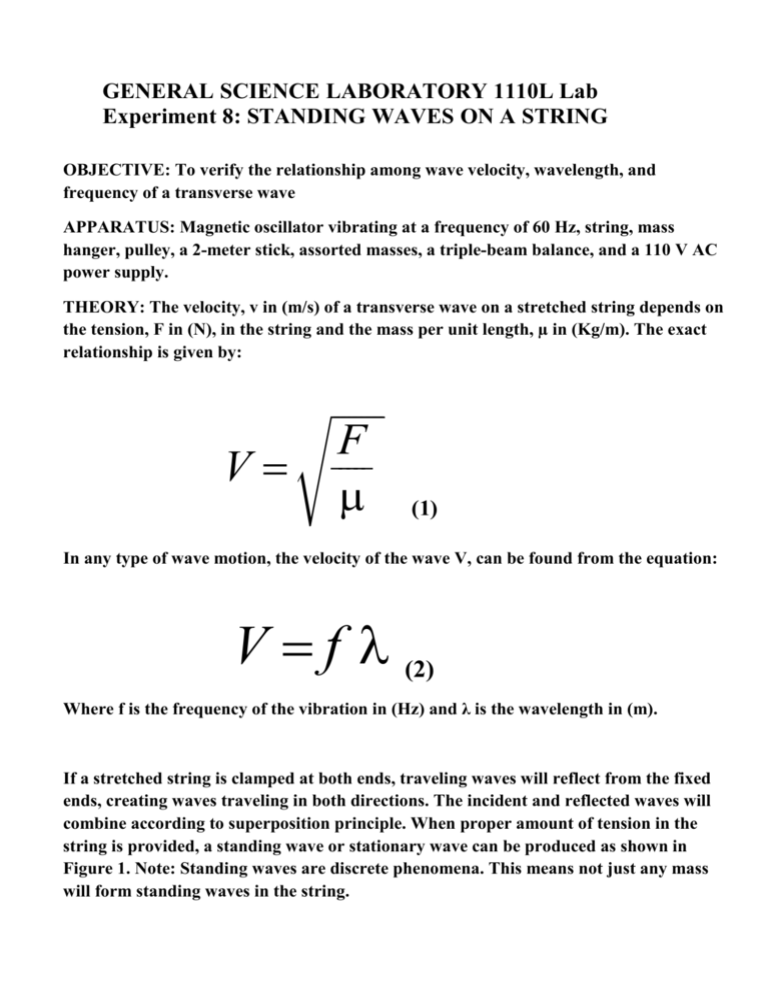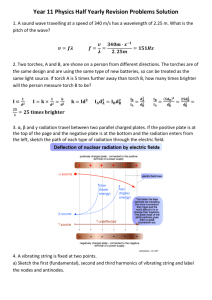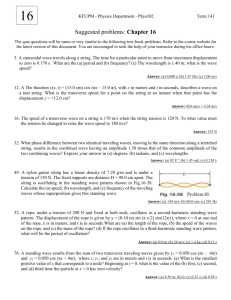Standing Waves on a String Lab
advertisement

GENERAL SCIENCE LABORATORY 1110L Lab Experiment 8: STANDING WAVES ON A STRING OBJECTIVE: To verify the relationship among wave velocity, wavelength, and frequency of a transverse wave APPARATUS: Magnetic oscillator vibrating at a frequency of 60 Hz, string, mass hanger, pulley, a 2-meter stick, assorted masses, a triple-beam balance, and a 110 V AC power supply. THEORY: The velocity, v in (m/s) of a transverse wave on a stretched string depends on the tension, F in (N), in the string and the mass per unit length, µ in (Kg/m). The exact relationship is given by: w w w w w w w w w w w w w w F f f f f f V =s µ (1) In any type of wave motion, the velocity of the wave V, can be found from the equation: V = f λ (2) Where f is the frequency of the vibration in (Hz) and λ is the wavelength in (m). If a stretched string is clamped at both ends, traveling waves will reflect from the fixed ends, creating waves traveling in both directions. The incident and reflected waves will combine according to superposition principle. When proper amount of tension in the string is provided, a standing wave or stationary wave can be produced as shown in Figure 1. Note: Standing waves are discrete phenomena. This means not just any mass will form standing waves in the string. Figure 1 shows a standing wave with a light, flexible string with one end attached to an oscillator and the other end passes over a fixed pulley to the weight, W. Along the string there are regions of no vibration called nodes, N, and regions of maximum vibration called antinodes, A. The segment between two nodes is called a loop. Since the length of one loop equals one-half the wavelength, the wavelength of the wave can be found by using eq.3. Fig. 2 shows an actual standing wave. f λ= 2 Figure 2 Standing Waves g Lffff n (3) Procedure 1. Clamp the Vibrator to the end of the long side of the lab table using the included C-Clamp. See Figure 3. Figure 3: Vibrator Clamped to end of Lab Table, 2. Clamp the pulley to the opposite end of the lab table. See Figure 4. Figure 4: Pulley clamped at opposite end of the lab table 3. Hang the mass hanger from the loop in the string. See Figure 5. Figure 5: Mass Hanger with Masses. 4. Measure the distance L from where the string is attached to the end of the vibrator to the center (axel) of the pulley and record it in your data table, 5. Use equation 4 to predict how much mass will be needed to create the number of loops in the standing wave. 2 4µ f L f f f f f f f f f f f f f f f f f f f m= 2 (4) gn 2 6. Everything is known or has been measured in equation (4) except n. 7. Use equation (4) to predict how much mass will form 2 loops. (n=2) 8. Adjust the string's tension by adding the amount of mass you predicted for 2 loops. Are any standing waves starting or form? 9. If there are standing waves forming, you need to adjust the amount of mass in small increments. 10. The object is to adjust the mass so as to make the antinodes as large as possible. 11. To see if you need to add a small bit of mass, press down gently on the mass hanger to increase the tension in the string, to see if the antinodes get larger. 12. If this is what happens, you need to add small amounts of mass until the antinodes are at their maximum height. (1, 2, or 5 gram masses at a time) 12. If you press down gently on the mass hanger, to increase the tension in the string, and the antinodes get smaller, it means you need to take mass off the hanger in small increments, until the antinodes are at their maximum height. 13. Weigh the mass hanger and masses together using the triple beam balance and record it as mass m, in the data table. 14. Follow steps 5 through 12 again for values of n equal to 3 and 4. DATA ANAYLISIS: For Each value of n. 1. Calculate the tension in the string, F, which is equal to the weight, F = mg. Place the result in your data table. 2. Draw a sketch of the standing wave pattern in the second column of the data table. 3 Calculate the wavelength λ using equation (3). 4. Calculate V using both equation (1) and equation (2).Place the results in your data table. 6. Calculate a % difference in the velocities using the two methods for all three values of n. Use the equation below. hL Mi L M Mm Measured @ Measured lLf 1 2 f f f f f f f f f f f f f f f f f f f f f f f f f f f f f f f f f f f f f f f f f f f f f f f f f f f f f f f f f f f f f l mX 100% % Difference =j Measured + Measured fff f f f f f f f f f f f f f f f f f f f f f f f f f f f f f f f f f f f f f f f f f f f f f f f f f f f f f f f f f f f f f f f f f f f k 1f 2f 2 SUGGESTED FORMAT FOR YOUR DATA TABLE IN YOUR LAB NOTEBOOK L=__________(m) f = 60 Hz µ =_________________(Kg/m) Trial Standing Wave Pattern. Draw with same length Number of Loops. n Total Mass m (g) Total Mass m (Kg) Tension (N) F=mg Wavelength λ in (m) Velocity V= F /μ in (m/s) Velocity V= f λ in (m/s) 1 2 3 Lab Report Format: Your lab report for this experiment should contain the following sections: 1. Title of experiment in center of the first page. Date to the left of the title. Experimenters name with partners name(s) under experimenters name to the right of the title. 2. Objective 3. Apparatus 4. Original Data: Neatly filled out data page. 5. Sample calculations: For this lab an example (ONE) calculation needs to be shown for each of the following: Calculate the predicted mass for one of the trials using equation (4). Tension F=mg. Wave length λ using equation (3). Velocity using equation (1). Velocity using equation (2). For one of the trials, calculate a % difference between two velocities found using the two different equations. 6. Results: State your results in the form of a 3 x 4 table. (3 Rows by 4 Columns). Make sure the numerical results are properly rounded and have the correct number of significant digits. Give your experimental values for n, the two velocities for each trial, and the % difference between the two methods. 7. Conclusions: Address the answers to the two discussion questions below. QUESTIONS 1. Comment on the wave velocity as a function of the number of loops on the wave. Does your experiment show that the two are directly proportional or inversely proportional? 2. The wave velocity calculated from both equations should be identical. Discuss the reasons of the differences. Give possible sources of error in this experiment. PROPER MATERIALS, ETC. FOR YOUR REPORTS 1. ALL DATA IS TO BE RECORDED DIRECTLY IN YOUR LAB NOTEBOOK. NO SCRATCH PAPER IS TO BE USED. 2. YOU ARE TO USE BLUE OR BLACK INK ONLY FOR RECORDING DATA AND DOING YOUR REPORTS IN YOUR NOTEBOOK. 3. REMEBER, ONLY THE FRONT OF THE PAGES IN YOUR LAB NOTEBOOK ARE TO BE USED FOR DOING YOUR LAB REPORT. I WILL NOT LOOK AT ANY INFORMATIION ON THE BACKSIDE OF THE NOTEBOOK PAGES. 4. DO NOT TEAR OUT ANY PAGES FROM YOUR NOTBOOK. 5.DO NOT ERASE OR USE WHITEOUT FOR MISTAKES!!!! All observations taken under the same experimental condition are equally valid and should be retained for analysis. Do not erase readings. If you must change a reading, draw a single line through it and then record the new measurement next to the old one.









